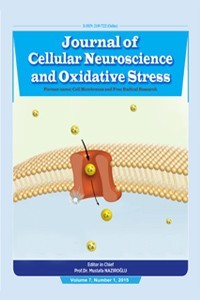Melatonin reduces lens oxidative stress level in STZ-induced diabetic rats through supporting glutathione peroxidase and reduced glutathione values
Hyperglycemia plays a critical role in the
development and progression of diabetic cataract oxidative injuries via the
increased reactive oxygen species (ROS) production. Melatonin
has been considered a potent strong antioxidant that detoxifies a
variety of ROS in many metabolic diseases. The present study was conducted to explore whether melatonin administration
protects against diabetic lens oxidative injuries through modulation of reduced
glutathione (GSH) and glutathione peroxidase (GPx) systems in streptozotocin
(STZ)-induced diabetic rats. Thirty two rats were
equally divided into four groups as control, STZ, melatonin and STZ and
melatonin. The third and fourth groups received intraperitoneal 10 mg/kg
melatonin for 2 weeks. For induction of diabetes in the second and fourth groups,
intraperitoneal STZ (45 mg/kg) was given.
Lipid peroxidation (MDA),
total oxidant status and intracellular ROS levels in the lens were increased in
STZ group although they were decreased by melatonin treatment. GPx activity,
GSH concentration and total antioxidant status (TAS) were lower in STZ group
than in control. However, the GSH concentration, GPx activity and TAS levels
were recovered by melatonin. TAS was also higher in melatonin group than in the
STZ and melatonin groups.
In conclusion, the present study shows that melatonin
induced protective effects against diabetes-induced lens oxidative injury
through up-regulation of the GSH and GPx values but down-regulation of
oxidative stress.
___
- Akash MS, Rehman K, Tariq M, Chen S. 2015. Zingiber officinale and Type 2 diabetes mellitus: evidence from experimental studies. Crit Rev Eukaryot Gene Expr. 25, 91-112.
- Balestri F, Cappiello M, Moschini R, Rotondo R, Abate M, Del-Corso A, Mura U. 2015. Modulation of aldose reductase activity by aldose hemiacetals. Biochim Biophys Acta. 1850, 2329-2339.
- Dilek M, Naziroğlu M, Baha Oral H, Suat Ovey I, Küçükayaz M, Mungan MT, Kara HY, Sütçü R. 2010. Melatonin modulates hippocampus NMDA receptors, blood and brain oxidative stress levels in ovariectomized rats. J Membr Biol. 233, 135-142.
- DU SC, Ge QM, Lin N, Dong Y, Su Q. 2012. ROS-mediated lipopolysaccharide-induced apoptosis in INS-1 cells by modulation of Bcl-2 and Bax. Cell Mol Biol (Noisy-le-grand). 58 Suppl, OL1654-1659.
- Ekmekcioglu C. 2006. Melatonin receptors in humans: biological role and clinical relevance. Biomed Pharm 60, 97-108.
- Erel O. 2004. A novel automated direct measurement method for total antioxidant capacity using a new generation, more stable ABTS radical cation. Clin Biochem 37, 277–285.
- Kador PF, Guo C, Kawada H, Randazzo J, Blessing K. 2014. Topical nutraceutical Optixcare EH ameliorates experimental ocular oxidative stress in rats. J Ocul Pharmacol Ther. 30(7), 593-602.
- Kahya MC, Nazıroğlu M, Çiğ B. 2017. Modulation of diabetes-induced oxidative stress, apoptosis, and Ca2+ entry through TRPM2 and TRPV1 channels in dorsal root ganglion and hippocampus of diabetic rats by melatonin and selenium. Mol Neurobiol. 54, 2345-2360.
- Khorsand M, Akmali M, Sharzad S, Beheshtitabar M. 2016. Melatonin reduces cataract formation and aldose reductase activity in lenses of streptozotocin-induced diabetic rat. Iran J Med Sci. 41, 305-313.
- Kovacic P, Somanathan R. 2008. Unifying Mechanism for Eye Toxicity: Electron transfer, reactive oxygen species, antioxidant benefits, cell signaling and cell Membranes. Cell Membr Free Radic Res 2, 56-69.
- Lawrence RA, Burk RF. 1976. Glutathione peroxidase activity in selenium-deficient rat liver. Biochem Biophys Res Commun 71, 952-958.
- Miranda-Díaz AG, Pazarín-Villaseñor L, Yanowsky-Escatell FG, Andrade-Sierra J. 2016. Oxidative stress in diabetic nephropathy with early chronic kidney disease. J Diabetes Res. 2016:7047238.
- Nazıroğlu M, Dikici DM, Dursun S. 2012. Role of oxidative stress and Ca(2+) signaling on molecular pathways of neuropathic pain in diabetes: Focus on TRP channels. Neurochem Res. 37, 2065-2075.
- Placer ZA, Cushman L, Johnson BC. 1966. Estimation of products of lipid peroxidation (malonyl dialdehyde) in biological fluids. Anal Biochem 16, 359-364.
- Reiter RJ, Acuña-Castroviejo D, Tan DX, Burkhardt S. 2001. Free radical-mediated molecular damage. Mechanisms for the protective actions of melatonin in the central nervous system. Ann N Y Acad Sci. 939, 200-215.
- Salmanoglu DS, Gurpinar T, Vural K, Ekerbicer N, Darıverenli E, Var A. 2016. Melatonin and L-carnitin improves endothelial disfunction and oxidative stress in Type 2 diabetic rats. Redox Biol. 8, 199-204.
- Sedlak J, Lindsay RHC. 1968. Estimation of total, protein bound and non-protein sulfhydryl groups in tissue with Ellmann' s reagent. Anal Biochem 25, 192-205.
- Sen CK, Packer L. 2000. Thiol homeostasis and supplements in physical exercise. Am J Clin Nutr. 72(2 Suppl), 653S-669S.
- Sharafati-Chaleshtori R, Shirzad H, Rafieian-Kopaei M, Soltani A. 2017. Melatonin and human mitochondrial diseases. J Res Med Sci. 22, 2.
- Singh U, Jialal I. 2008. Alpha-lipoic acid supplementation and diabetes. Nutr Rev. 66, 646-657.
- Srivastava SK, Yadav UC, Reddy AB, Saxena A, Tammali R, Shoeb M, Ansari NH, Bhatnagar A, Petrash MJ, Srivastava S, Ramana KV. 2011. Aldose reductase inhibition suppresses oxidative stress-induced inflammatory disorders. Chem Biol Interact. 191, 330-338.
- Suresha BS, Srinivasan K. 2013. Antioxidant potential of fungal metabolite nigerloxin during eye lens abnormalities in galactose-fed rats. Curr Eye Res. 38(10), 1064-1071.
- Tök L, Nazıroğlu M, Doğan S, Kahya MC, Tök O. 2014. Effects of melatonin on Wi-Fi-induced oxidative stress in lens of rats. Indian J Ophthalmol. 62, 12-15.
- Urata Y, Honma S, Goto S, Todoroki S, Iida T, Cho S, Honma K, Kondo T. 1999. Melatonin induces gamma-glutamylcysteine synthetase mediated by activator protein-1 in human vascular endothelial cells. Free Radic Biol Med. 27(7-8), 838-847.
- Wang F, Ma J, Han F, Guo X, Meng L, Sun Y, Jin C, Duan H, Li H, Peng Y. 2016. DL-3-n-butylphthalide delays the onset and progression of diabetic cataract by inhibiting oxidative stress in rat diabetic model. Sci Rep. 6, 19396.
- Yayın Aralığı: Yıllık
- Başlangıç: 2008
- Yayıncı: Hücresel Sinir Bilimleri ve Oksidatif Stres Derneği
